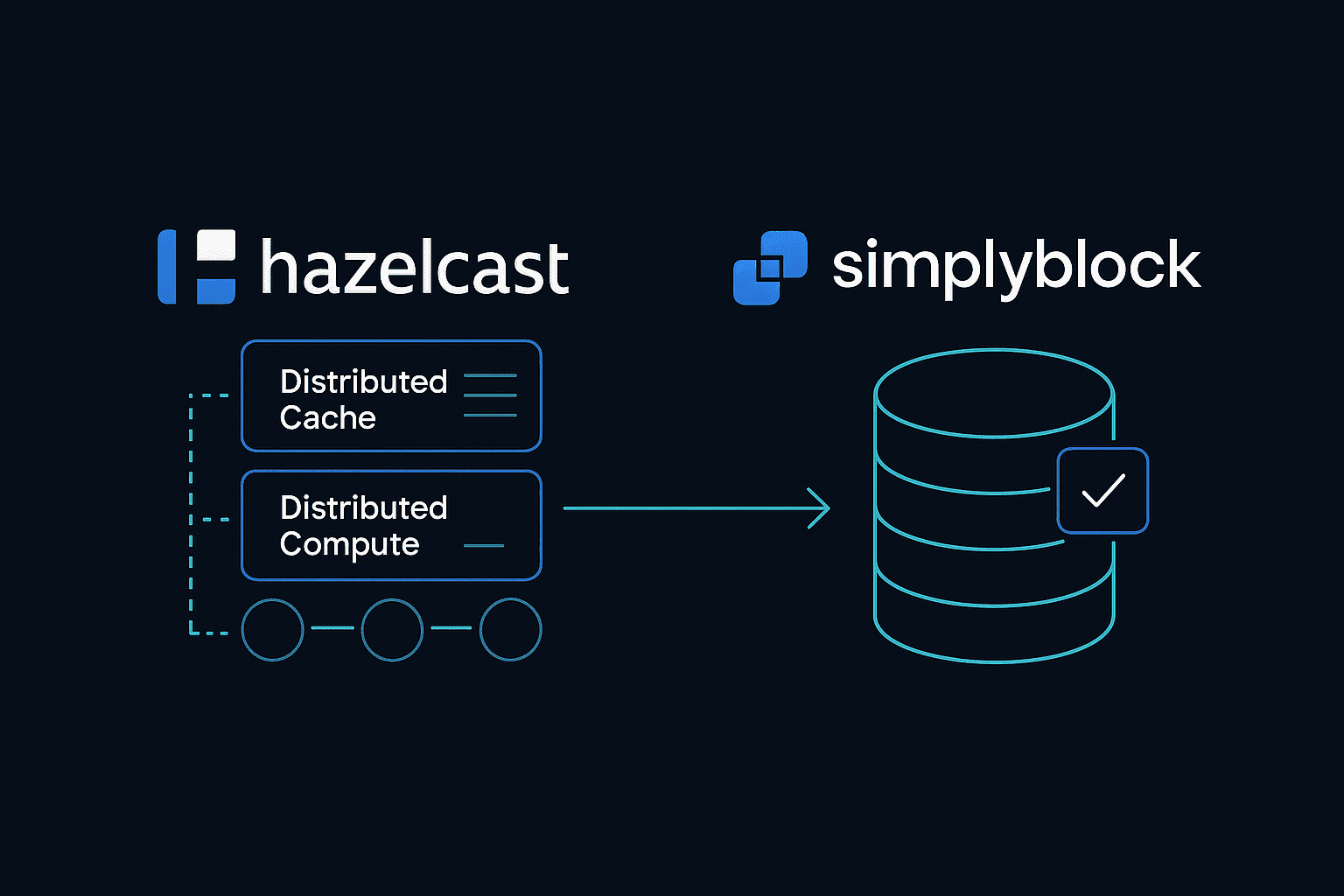Hazelcast is an in-memory data grid designed for real-time caching, event streaming, and fast data processing. It provides distributed storage for frequently accessed data, but as clusters scale, performance is often constrained by the underlying persistence layer.
Simplyblock helps address this by offering NVMe-over-TCP storage and zone-independent volumes. Together, Hazelcast and simplyblock enable fast caching with reliable durability, even as workloads grow across multiple environments.
Storage Needs in Hazelcast Environments
Hazelcast is memory-first, but persistence is essential for failover, recovery, and maintaining state between restarts. Without optimized storage, backup writes can become a bottleneck, causing recovery delays and inconsistent performance.
By integrating simplyblock, Hazelcast clusters benefit from high-throughput storage that supports durability without slowing down memory-speed operations. Zone independence further ensures that caches and persisted data remain accessible during rescheduling or failover.
🚀 Use simplyblock with Hazelcast for Durable Storage
Simplyblock improves persistence speed and supports large-scale in-memory caching.
👉 Use simplyblock for Databases on Kubernetes →
Step 1: Preparing Persistent Volumes for Hazelcast
Start by provisioning simplyblock volumes to persist Hazelcast data across nodes:
sbctl pool create hazelcast-pool /dev/nvme0n1
sbctl volume add hazelcast-store 100G hazelcast-pool
sbctl volume connect hazelcast-store
Format and mount the volume:
mkfs.ext4 /dev/nvme0n1
mkdir -p /var/lib/hazelcast
mount /dev/nvme0n1 /var/lib/hazelcast
Update /etc/fstab to make the mount persistent:
/dev/nvme0n1 /var/lib/hazelcast ext4 defaults 0 0
This ensures Hazelcast state persistence is handled by high-speed volumes.

Step 2: Configuring Hazelcast to Use Simplyblock Storage
Once volumes are available, configure Hazelcast to use the mounted directory for persistence. In the Hazelcast XML configuration:
<persistence enabled=”true”>
<base-dir>/var/lib/hazelcast</base-dir>
</persistence>
Restart the cluster nodes after updating the configuration. Detailed options are provided in the Hazelcast persistence reference.
Step 3: Increasing Hazelcast Storage Capacity
As Hazelcast clusters handle larger workloads, persistence volumes may need to grow. Simplyblock makes this seamless by resizing volumes online:
sbctl volume resize hazelcast-store 200G
resize2fs /dev/nvme0n1
This avoids downtime and keeps caches and backups available. Paired with software-defined storage, scaling becomes efficient across distributed applications.
Step 4: Deploying Hazelcast Across Zones
To maintain availability, Hazelcast is often deployed across multiple zones. Standard storage tied to a single zone complicates recovery. Simplyblock solves this with zone-independent volumes, ensuring Hazelcast persists data consistently even when nodes move between zones.
This approach strengthens recovery strategies similar to multi-availability zone disaster recovery.
Step 5: Replicating Hazelcast Data with Simplyblock
Hazelcast supports replication across nodes, but storage replication adds another layer of reliability. With simplyblock, volumes can be mirrored across zones:
sbctl volume replicate hazelcast-store –zones=zone-a,zone-b
This reduces RPO and RTO, ensuring Hazelcast clusters recover quickly during disruptions. Cluster setup recommendations are explained in the Hazelcast clustering documentation.
Managing Hazelcast Storage at Scale
At enterprise scale, Hazelcast requires reliable persistence and simplified operations. Simplyblock provides CLI-driven storage management that reduces administrative overhead.
Capabilities such as Kubernetes backup and hybrid multi-cloud support make it easier to integrate Hazelcast into modern enterprise environments. Technical references are available in the simplyblock Documentation.
Questions and Answers
Simplyblock provides ultra-low-latency NVMe storage that speeds up Hazelcast’s durable persistence. By reducing write delays, it ensures faster recovery from node failures and more stable performance for in-memory data grids.
Yes, simplyblock’s software-defined storage delivers consistent throughput across nodes, helping Hazelcast maintain low-latency operations even during heavy workloads. Features like database performance optimization make it ideal for data-intensive use cases.
Absolutely. With enterprise features like encryption, snapshots, and replication, simplyblock enables Hazelcast clusters to maintain data reliability. This ensures applications running on Hazelcast can achieve both high availability and compliance.
Cloud disks often suffer from inconsistent performance under load, while simplyblock offers predictable NVMe-backed storage. This consistency is crucial for Hazelcast clusters that rely on reliable persistence for distributed caching and real-time data processing.
Simplyblock provides the flexibility to run Hazelcast across on-premises and cloud environments without sacrificing performance. Its RPO and RTO reduction capabilities make disaster recovery faster and more efficient in hybrid setups.

